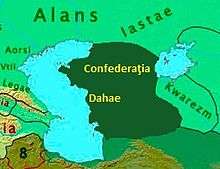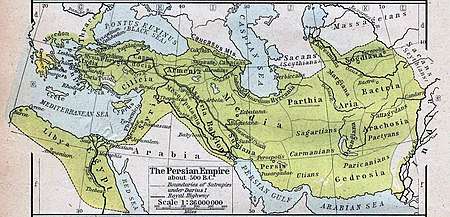Dahae
The Dahae, also known as the Daae, Dahas or Dahaeans (Latin: Dahae; Persian: داهان Dahan; Ancient Greek: Δάοι, Δάαι, Δαι, Δάσαι Dáoi, Dáai, Dai, Dasai; Sanskrit: Dasa; Chinese: 大益 Dayi)[1][2] were an Iranian[3] people of ancient Central Asia. A confederation of three tribes – the Parni, Xanthii and Pissuri – the Dahae lived in an area now comprising much of modern Turkmenistan. The area has consequently been known as Dahestan, Dahistan and Dihistan (Persian: دهستان).
| Dahae Daae | |
|---|---|
| People | |
 | |
| Location | present-day Turkmenistan |
| Branches | Parni, Xanthii and Pissuri |
Relatively little is known about their way of life. For example, according to the Iranologist A. D. H. Bivar, the capital of "the ancient Dahae (if indeed they possessed one) is quite unknown."[4]
The Dahae dissolved, apparently, some time before the beginning of the 1st millennium. One of the three tribes of the Dahae confederation, the Parni, emigrated to Parthia (present-day north-eastern Iran), where they founded the Arsacid dynasty.
Origins
The Dahae may be connected to the Dasas (Sanskrit दास Dāsa), mentioned in ancient Hindu texts such as the Rigveda as enemies of the Ārya. The proper noun Dasa appears to share the same root as the Sanskrit dasyu, meaning "hostile people" or "demons" (as well as the Avestan dax́iiu and Old Persian dahyu or dahạyu, meaning "province" or "mass of people"). Because of these pejorative implications, a tribe called the Dāhī – mentioned in Avestan sources (Yašt 13.144) as adhering to Zoroastrianism – is not generally identified with the Dahae.[5] Conversely the Khotanese word daha- meaning "man" or "male" was linked to the Dahae by the Indologist Sten Konow (1912). This appears to be cognate with nouns in other Eastern Iranian languages, such as a Persian word for "servant", dāh and the Sogdian dʾyh or dʾy, meaning "slave woman".[5]
Some scholars also maintain that there were etymological links between the Dahae and Dacians (Dacii), a people of ancient Eastern Europe.[6] Both were nomadic Indo-European peoples who shared variant names such as Daoi. David Gordon White, an Indologist and historian of religion, has reiterated a point made by previous scholars – that the names of both peoples resemble the Proto-Indo-European root: *dhau meaning "strangle" and/or a euphemism for "wolf". (Similarly, the Massagetae, the northern neighbors of the Dahae, have been linked to the Getae, a people related to the Dacians.)
The country neighbouring the Dahae to the south, Verkāna – often known by its Greek name, Hyrcania (Ὑρκανία) – has sometimes been conflated with Dahistan. Like Dahae and Dacia, Verkâna appears to have a root in an Indo-European word for "wolf", the Proto-Iranian: *vrka.[7] The name of Sadrakarta (later Zadracarta), the capital of Verkâna, apparently has the same etymological roots, and may be synonymous with one of two modern cities in Iran: Sari or Gorgan. (The modern name Gorgan is also derived ultimately from the Proto-Iranian *vrka for "wolf" and is cognate with the New Persian gorgān (i.e. v > g).[8]
History
Berossus's biography of Cyrus the Great (c. 589–530 BCE) claims that he was killed by the Dahae near the Syr Darya (Jaxartes) river (modern Uzbekistan/Kazakhstan).[9] Later sources, such as Alexander the Great and Strabo also claimed that some of the Dahae were located near the Jaxartes. The Encyclopedia Iranica considers that the Dahae "were said to have lived in ... wastes northeast of Bactria and east of Sogdiana. At least some of the Dahae must thus be placed along the eastern fringes of the Karakum desert, near ancient Margiana..."[5] This suggests that elements of the Dahae were near neighbours of a now-obscure Bronze Age civilisation known to archaeologists as the Bactria-Margiana Archaeological Complex (BMAC).
It is possible that the Dahae were confused in secondary accounts with a contemporaneous, possibly related people from Balkh (Bactria), who were known in ancient China as Daxia 大夏 (also Ta-Hsia, or Ta-Hia). Whereas the Dahae were known in Chinese sources as Dayi 大益.[1] Later historical accounts place the Dahae entirely on the south-eastern shores of the Caspian Sea.
The first reliable mention of the Dahae is considered to be the Daeva inscription by Xerxes the Great of Persia (reigned 486–465 BCE). In a list in Old Persian of the peoples and provinces of the Achaemenid Empire, the Daeva identifies the Dāha as neighboring the Saka.
It is unclear whether the Dahae are also the *Dāha or *Dåŋha (only attested in the feminine Dahi) mentioned by the Avestani Yasht (13.144), which may date from the 5th century BCE. Moreover, any etymological relationship would not be proof that both names refer to exactly the same people.[10]
Dahae and Saka tribes are known to have fought at the Battle of Gaugamela (331 BCE), in which the armies of the Achaemenid Empire were defeated by Alexander the Great. After the Achaemenid dynasty collapsed the following year, Alexander recruited Dahae – famed as mounted archers – for the Greek invasion of India.
Some "Saka" coins from the Seleucid era (312–63 BCE) are sometimes attributed to the Dahae. By the 3rd century BCE, the Parni Dahae had risen to prominence under a chief named Ashk (c. 250 – c. 211 BCE; Persian: ارشک Arshak; Greek Ἀρσάκης; Latin Arsaces). The Parni invaded Parthia, which had just previously declared independence from the Seleucids, deposed the reigning monarch, and Ashk crowned himself king (Arsaces I in classical sources). His successors are often referred to as the Arsacids; they would eventually assert military control over the entire Iranian plateau. By then, the Parni would be indistinguishable from the Parthians, and would also be called by that name.
During the 1st Century BCE, the Dahae were reported to have sent envoys to China. According to the Chinese historian Yu Taishan, a contemporary Chinese account (the Shijii) mentions separate envoys from Huanqian 驩潛 (Khwarezm), Dayi 大益 (the Dahae) and Suxie 蘇薤 (Soghdia), among others.[1]
In the 1st century BCE, Strabo (Geographika 11.8.1) also refers to the Dahae as a "Scythian" people, who were located in the vicinity of present-day Turkmenistan. However, while the terms Scythians and Saka are usually regarded as synonymous, that is not always the case with Strabo.
See also
References
- ([spp131_chinese_dynasties_western_region.pdf Yu Taishan, 2004, "A History of the Relationship Between the Western & Eastern Han, Wei, Jin, Northern & Southern Dynasties and the Western Regions", Sino-Platonic Papers, no. 131 (March)], p. 19.
- Francisco Rodríguez Adrados (1994). basileutos – daimōn, Vol 4, p. 859: "Δαι"
- Daryaee 2011, p. 168 "Our knowledge of the making of the Parthian state and of its chronology is full of gaps. We know that it was started by the nomadic tribe of Parni (or Aparni), belonging to the Dahae group of Iranian peoples."
- Bivar 1993, p. 27.
- François de Blois & Willem Vogelsang, 2011, "Dahae", Encyclopedia Iranica (23 May 2015).
- David Gordon White, 1991, Myths of the Dog-Man, Chicago, University of Chicago Press, pp. 27, 239.
- The Old Iranian/Old Persian verka "wolf" was recorded in Darius the Great's Behistun Inscription of 522 BCE), as well as other Old Persian cuneiform inscriptions. There is evidence for an etymological link between Verkāna and an Indo-European root meaning "wolf", in related languages including: Avestan vəhrka, Gilaki and Mazandarani Verk, Modern Persian gorg, and Sanskrit Vŗka (वृक) and Old Norse Warg.
- The 'v > g shift is also seen also seen, for example, in two words for "boar": Avestan varāza and New Persian gorāz.)
- M. A. Dandamaev, A political history of the Achaemenid empire, Leiden, Brill, 1989, p. 67
- de Blois 1993, p. 581.
Bibliography
- Bivar, A.D.H. (1993), "The Political History of Iran under the Arsacids", in Fischer, W.B.; Gershevitch, Ilya (eds.), Cambridge History of Iran, 3.1, London: Cambridge UP, pp. 21–99
- de Blois, François (1993), "Dahae I: Etymology", Encyclopaedia Iranica, 6, Costa Mesa: Mazda, p. 581
- Daryaee, Touraj (2011). The Oxford Handbook of Iranian History. Oxford University Press. ISBN 0199875758.CS1 maint: ref=harv (link)

